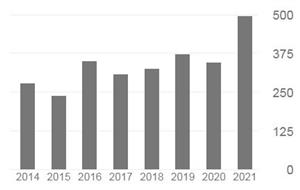Microstructure and Chemical Analysis of Four Calcium Silicate-Based Cements in Different Environmental Conditions
Abstract
Objective The objective of this study was to analyze the microstructure and crystalline structures of ProRoot MTA, Biodentine, CEM Cement, and Retro MTA when exposed to phosphate-buffered saline, butyric acid, and blood.
Methods and materials Mixed samples of ProRoot MTA, Biodentine, CEM Cement, and Retro MTA were exposed to either phosphate-buffered saline, butyric acid, or blood. Scanning electron microscope (SEM) and energy-dispersive X-ray spectroscopic (EDX) evaluations were conducted of specimens. X-ray diffraction (XRD) analysis was also performed for both hydrated and powder forms of evaluated calcium silicate cements.
Results The peak of tricalcium silicate and dicalcium silicate detected in all hydrated cements was smaller than that seen in their unhydrated powders. The peak of calcium hydroxide (Ca(OH)2) in blood- and acid-exposed ProRoot MTA, CEM Cement, and Retro MTA specimens were smaller than that of specimens exposed to PBS. The peak of Ca(OH)2 seen in Biodentine™ specimens exposed to blood was similar to that of PBS-exposed specimens. On the other hand, those exposed to acid exhibited smaller peaks of Ca(OH)2.
Conclusion Exposure to blood or acidic pH decreased Ca(OH)2 crystalline formation in ProRoot MTA, CEM Cement and Retro MTA. However, a decrease in Ca(OH)2 was only seen when Biodentine™ exposed to acid.
Clinical relevance The formation of Ca(OH)2 which influences the biological properties of calcium silicate cements was impaired by blood and acid exposures in ProRoot MTA, CEM Cement, and Retro MTA; however, in the case of Biodentine, only exposure to acid had this detrimental effect.
Keywords: Biodentine, Calcium Silicate Cement, CEM Cement, EDX, MTA, SEM, XRD.














